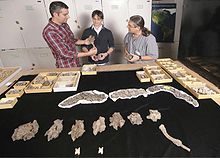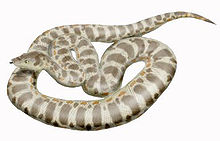- Titanoboa
-
Titanoboa
Temporal range: 60–58 Ma Paleocene
Titanoboa vertebrae (top & middle), Anaconda vertebrae (bottom). Scientific classification Kingdom: Animalia Phylum: Chordata Class: Reptilia Order: Squamata Suborder: Serpentes Family: Boidae Subfamily: Boinae Genus: Titanoboa
Head, 2009Species - T. cerrejonensis
Titanoboa, pronounced /taɪˌtænəˈboʊ.ə/ ty-tan-ə-boh-ə, meaning "titanic boa,"[1] is a genus of snake that lived approximately 58 to 60 million years ago, in the Paleocene epoch,[2] a 10-million-year period immediately following the dinosaur extinction event.[3] The only known species is the Titanoboa cerrejonensis, the largest snake ever discovered,[2] which supplanted the previous record holder, Gigantophis.
Contents
Size
By comparing the sizes and shapes of its fossilized vertebrae to those of extant snakes, researchers estimated that the T. cerrejonensis reached a maximum length of 12 to 15 m (40 to 50 ft),[4] weighed about 1,135 kg (2,500 lb),[1] and measured about 1 m (3 ft) in diameter at the thickest part of the body.[5][6]
Comparison with living snakes
The largest eight of the 28 T. cerrejonensis snakes found were between 12 and 15 m (40 and 50 ft) in length. In comparison, the largest extant snakes are the Python reticulatus, which measures up to 8.7 metres (29 ft) long,[7] and the anaconda, which measures up to 5.21 metres (17 ft) long[7] and is considered the heaviest snake on Earth. At the other end of the scale, the smallest extant snake is Leptotyphlops carlae with a length of about 10 centimetres (4 in).[8]
Location
In 2009, the fossils of 28 individual T. cerrejonensis were announced to have been found from the Cerrejón Formation in the coal mines of Cerrejón in La Guajira, Colombia.[1][2] Prior to this discovery, few fossils of Paleocene-epoch vertebrates had been found in ancient tropical environments of South America.[9] The snake was discovered on an expedition by a team of international scientists led by Jonathan Bloch, a University of Florida vertebrate paleontologist, and Carlos Jaramillo, a paleobotanist from the Smithsonian Tropical Research Institute in Panama.[10]
Climate
Because snakes are ectothermic, the discovery implies that the tropics, the creature's habitat, must have been warmer than previously thought, averaging approximately 30 °C (90 °F).[1][2][11][12] The warmer climate of the Earth during the time of T. cerrejonensis allowed cold-blooded snakes to attain much larger sizes than modern snakes.[13] Today, larger ectothermic animals are found in the tropics, where it is hottest, and smaller ones are found further from the equator.[3]
Robotic Titanoboa
In 2011 Charlie Brinson and his team created a 35 foot long electro-mechanical, robotic reincarnation of the Titanoboa snake, using 20 high strength aluminum vertebrae and 40 proportional hydraulic cylinders. There are plans to extend it to the full 50 foot length. [14]
References
- ^ a b c d Head, Jason J.; Jonathan I. Bloch, Alexander K. Hastings, Jason R. Bourque, Edwin A. Cadena, Fabiany A. Herrera, P. David Polly, and Carlos A. Jaramillo (2009). "Giant boid snake from the paleocene neotropics reveals hotter past equatorial temperatures.". Nature 457 (7230): 715–718. doi:10.1038/nature07671. PMID 19194448. http://www.nature.com/nature/journal/v457/n7230/abs/nature07671.html. Retrieved 2009-02-05.
- ^ a b c d Kwok, Roberta (4 February 2009). "Scientists find world's biggest snake". Nature. http://www.nature.com/news/2009/090204/full/news.2009.80.html. Retrieved 2009-02-04.
- ^ a b "Science Daily: At 2,500 Pounds And 43 Feet, Prehistoric Snake Is Largest On Record". ScienceDaily. 2009-02-04. http://www.sciencedaily.com/releases/2009/02/090204112217.htm. Retrieved 2009-02-06.
- ^ "CTV.ca | Ancient, gargantuan snakes ate crocs for breakfast". http://www.ctv.ca/servlet/ArticleNews/story/CTVNews/20090204/snake_biggest_090204/20090204?hub=SciTech. Retrieved 2009-02-07.
- ^ McIlroy, Anne (2009-02-05). "Titanoboa made anaconda look like a garter snake". Science. http://www.theglobeandmail.com/servlet/story/RTGAM.20090205.wsnake05/BNStory/Science/home. Retrieved 2009-02-06.
- ^ Dunham, Will (2009-02-04). "Titanic ancient snake was as long as Tyrannosaurus". Reuters UK. http://uk.reuters.com/article/oddlyEnoughNews/idUKTRE5136K320090204. Retrieved 2009-02-06.
- ^ a b Murphy JC, Henderson RW. 1997. Tales of Giant Snakes: A Historical Natural History of Anacondas and Pythons. Krieger Pub. Co. 221 pp. ISBN 0894649957.
- ^ S. Blair Hedges (August 4, 2008). "At the lower size limit in snakes: two new species of threadsnakes (Squamata: Leptotyphlopidae: Leptotyphlops) from the Lesser Antilles" (PDF). Zootaxa 1841: 1–30. http://www.mapress.com/zootaxa/2008/f/zt01841p030.pdf. Retrieved 2008-08-04.
- ^ Maugh II, Thomas H. (4 February 2009). "Fossil of 43-foot super snake Titanoboa found in Colombia". Los Angeles Times. http://www.latimes.com/news/nationworld/world/la-sci-snake5-2009feb05,0,6550292.story. Retrieved 2009-02-04.
- ^ "At 2,500 Pounds And 43 Feet, Prehistoric Snake Is Largest On Record". Science Daily. February 4, 2009. http://www.sciencedaily.com/releases/2009/02/090204112217.htm. Retrieved 2009-02-04.
- ^ Joyce, Christopher (5 February 2009). "1-Ton Snakes Once Slithered In The Tropics". NPR. http://www.npr.org/templates/story/story.php?storyId=100262412. Retrieved 2009-02-05.
- ^ "ScienceDirect - Palaeogeography, Palaeoclimatology, Palaeoecology : Climate model sensitivity to atmospheric CO2 levels in the Early–Middle Paleogene". http://www.sciencedirect.com/science?_ob=ArticleURL&_udi=B6V6R-47S6RC4-3&_user=10&_rdoc=1&_fmt=&_orig=search&_sort=d&view=c&_acct=C000050221&_version=1&_urlVersion=0&_userid=10&md5=f53378580e88505b71158a35999e10ef. Retrieved 2009-02-07.
- ^ Makarieva, A. M.; Victor G. Gorshkov and Bai-Lian Li (2005-09-14). "Gigantism, temperature and metabolic rate in terrestrial poikilotherms". Proceedings of the Royal Society B 272 (1578): 2325–2328. doi:10.1098/rspb.2005.3223. PMC 1560189. PMID 16191647. http://journals.royalsociety.org/content/p30384h277127964/. Retrieved 2009-02-07.
- ^ http://titanoboa.ca/
External links
- A Snake the Size of a Plane: How did prehistoric animals get so big? By Nina Shen Rastogi. Feb. 5, 2009.
Fossil snakes Genera with hindlimbs and a sacrum Genera with hindlimbs only Madtsoiidae Dinilysiidae Palaeophiidae Boidae TitanoboaCategories:- Boinae
- Boinae by common name
- Paleocene reptiles
- Prehistoric reptiles of South America
- Fossil taxa described in 2009
Wikimedia Foundation. 2010.

